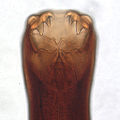Ancylostoma caninum
Ancylostoma caninum[edit]
-
Anterior end of Ancylostoma caninum
-
Canine hookworm egg
-
Hookworms
-
Ancylostoma caninum
Ancylostoma caninum[edit]
Ancylostoma caninum is a species of hookworm that primarily infects dogs, but can also affect other mammals, including humans. It is a parasitic nematode that resides in the small intestine of its host, where it attaches to the intestinal wall and feeds on blood, leading to anemia and other health issues.
Life Cycle[edit]
The life cycle of Ancylostoma caninum involves several stages:
- Eggs: The adult female hookworm lays eggs in the host's intestine, which are then excreted in the feces.
- Larvae: The eggs hatch in the environment, releasing larvae. These larvae undergo several molts, developing into infective third-stage larvae.
- Infection: The infective larvae can penetrate the skin of a new host or be ingested. Once inside the host, they migrate to the lungs, are coughed up, swallowed, and eventually reach the small intestine.
- Maturation: In the small intestine, the larvae mature into adult worms, completing the cycle.
Pathogenesis[edit]
Ancylostoma caninum causes hookworm disease in dogs, characterized by symptoms such as diarrhea, weight loss, and lethargy. The worms attach to the intestinal mucosa, causing blood loss and leading to iron deficiency anemia. In severe cases, especially in puppies, the infection can be fatal.
Zoonotic Potential[edit]
Ancylostoma caninum is of zoonotic concern, meaning it can infect humans. The larvae can penetrate human skin, causing a condition known as cutaneous larva migrans, characterized by itchy, serpiginous tracks on the skin. Although the larvae do not mature into adult worms in humans, the condition can be uncomfortable and requires medical attention.
Diagnosis[edit]
Diagnosis of Ancylostoma caninum infection is typically made through fecal examination to identify hookworm eggs. In some cases, blood tests may be used to assess the severity of anemia and other related conditions.
Treatment and Control[edit]
Treatment of Ancylostoma caninum infection in dogs involves the use of anthelmintic medications, such as pyrantel pamoate, fenbendazole, or ivermectin. Preventive measures include regular deworming, maintaining good hygiene, and controlling environmental contamination to reduce the risk of infection.
Related Pages[edit]
| Parasitic diseases | ||||||||
|---|---|---|---|---|---|---|---|---|
This parasitic disease-related article is a stub.
|
| Veterinary medicine | ||||||||||
|---|---|---|---|---|---|---|---|---|---|---|
|
Ad. Transform your life with W8MD's Budget GLP-1 injections from $75


W8MD offers a medical weight loss program to lose weight in Philadelphia. Our physician-supervised medical weight loss provides:
- Weight loss injections in NYC (generic and brand names):
- Zepbound / Mounjaro, Wegovy / Ozempic, Saxenda
- Most insurances accepted or discounted self-pay rates. We will obtain insurance prior authorizations if needed.
- Generic GLP1 weight loss injections from $75 for the starting dose.
- Also offer prescription weight loss medications including Phentermine, Qsymia, Diethylpropion, Contrave etc.
NYC weight loss doctor appointmentsNYC weight loss doctor appointments
Start your NYC weight loss journey today at our NYC medical weight loss and Philadelphia medical weight loss clinics.
- Call 718-946-5500 to lose weight in NYC or for medical weight loss in Philadelphia 215-676-2334.
- Tags:NYC medical weight loss, Philadelphia lose weight Zepbound NYC, Budget GLP1 weight loss injections, Wegovy Philadelphia, Wegovy NYC, Philadelphia medical weight loss, Brookly weight loss and Wegovy NYC
|
WikiMD's Wellness Encyclopedia |
| Let Food Be Thy Medicine Medicine Thy Food - Hippocrates |
Medical Disclaimer: WikiMD is not a substitute for professional medical advice. The information on WikiMD is provided as an information resource only, may be incorrect, outdated or misleading, and is not to be used or relied on for any diagnostic or treatment purposes. Please consult your health care provider before making any healthcare decisions or for guidance about a specific medical condition. WikiMD expressly disclaims responsibility, and shall have no liability, for any damages, loss, injury, or liability whatsoever suffered as a result of your reliance on the information contained in this site. By visiting this site you agree to the foregoing terms and conditions, which may from time to time be changed or supplemented by WikiMD. If you do not agree to the foregoing terms and conditions, you should not enter or use this site. See full disclaimer.
Credits:Most images are courtesy of Wikimedia commons, and templates, categories Wikipedia, licensed under CC BY SA or similar.
Translate this page: - East Asian
中文,
日本,
한국어,
South Asian
हिन्दी,
தமிழ்,
తెలుగు,
Urdu,
ಕನ್ನಡ,
Southeast Asian
Indonesian,
Vietnamese,
Thai,
မြန်မာဘာသာ,
বাংলা
European
español,
Deutsch,
français,
Greek,
português do Brasil,
polski,
română,
русский,
Nederlands,
norsk,
svenska,
suomi,
Italian
Middle Eastern & African
عربى,
Turkish,
Persian,
Hebrew,
Afrikaans,
isiZulu,
Kiswahili,
Other
Bulgarian,
Hungarian,
Czech,
Swedish,
മലയാളം,
मराठी,
ਪੰਜਾਬੀ,
ગુજરાતી,
Portuguese,
Ukrainian



